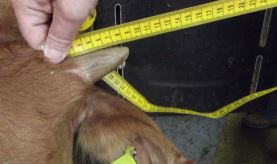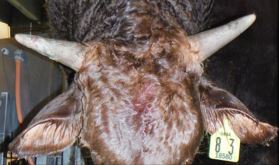



How Much do Horns Grow Through the Feedlot Phase?
Even with polled genetics increasing, horned cattle still raise welfare issues, a Kansas State University study has shown.The objective of this study was to determine horn growth during the finishing phase in feedlot cattle. Measurements taken on heifers upon arrival to the feedlot and again at the abattoir included tip-to-tip, length of one horn, and base circumference of one horn.
The cattle (n = 30) were primarily beef breeds with Brahman and Longhorn influence and were on feed 194 days in southwest Kansas.

Some horns were damaged during the feeding period and at the abattoir before measurements were taken. The average initial and final measurements for tip-to-tip length were 33.0 and 44.4 cm, lengths of one horn were 9.5 and 17.0 cm, and for base circumference were 13.1 and 16.2 cm, respectively.
The average tip-to-tip length growth was 11.4 cm, the average length of one horn growth was 7.5 cm, and the average base circumference growth was 3.2 cm.
Animals were categorized into 25, 50, 75, and 100 percentile groups by initial measurements and growth measurement averages were compared.
Measurements for tip-to-tip growth were 6.1, 16.0, 12.7, and 13.1 cm, for one horn length growth were 9.0, 7.2, 5.0, and 5.8 cm, respectively with no statistically significant differences.
Conclusion
Initial measures were not indicative of growth during the feeding period, and horn growth averaged 1.2 cm (approximately 0.5 inches) per month during the observed feeding period.

Horn growth during the feeding period should be considered during tipping decisions to decrease pain and welfare issues for incoming cattle.
Horn: A Problem Not Going Away
The prevalence of horned cattle arriving at the abattoir was 23.8 percent in 2011 — a slight increase from 22.3 percent of cattle in 2005, according to the National Beef Quality Audit in 2011.
Horned cattle are often associated with human and cohort injury, therefore the current industry standard is to tip horns at the feedlot.
Tipping is removing only a portion of the horn, but is often accompanied by pain issues. The necessity of tipping is often questioned due to these associated pain issues, however, there is no current documentation.


